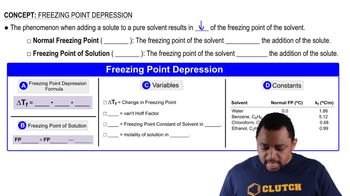Use the normal boiling points propane (C3H8) -42.1 °C butane (C4H10) -0.5 °C pentane (C5H12) 36.1 °C hexane (C6H14) 68.7 °C heptane (C7H16) 98.4 °C to estimate the normal boiling point of octane (C8H18). Explain the trend in the boiling points.
(b) A flask of water is connected to a vacuum pump. A few moments after the pump is turned on, the water begins to boil. After a few minutes, the water begins to freeze. Explain why these processes occur.
 Verified step by step guidance
Verified step by step guidance
Verified video answer for a similar problem:
Key Concepts
Boiling Point and Vapor Pressure

Freezing Point and Pressure

Phase Changes and Energy Transfer

(a) When you exercise vigorously, you sweat. How does this help your body cool?
The following table gives the vapor pressure of hexafluorobenzene (C6F6) as a function of temperature: (a) By plotting these data in a suitable fashion, determine whether the Clausius–Clapeyron equation (Equation 11.1) is obeyed. If it is obeyed, use your plot to determine ∆Hvap for C6F6.
Suppose the vapor pressure of a substance is measured at two different temperatures. (a) By using the Clausius–Clapeyron equation (Equation 11.1) derive the following relationship between the vapor pressures, P1 and P2, and the absolute temperatures at which they were measured, T1 and T2: (b) Gasoline is a mixture of hydrocarbons, a component of which is octane (CH3CH2CH2CH2CH2CH2CH2CH3). Octane has a vapor pressure of 13.95 torr at 25 °C and a vapor pressure of 144.78 torr at 75 °C. Use these data and the equation in part (a) to calculate the heat of vaporization of octane. (c) By using the equation in part (a) and the data given in part (b), calculate the normal boiling point of octane. Compare your answer to the one you obtained from Exercise 11.81. (d) Calculate the vapor pressure of octane at - 30 °C.
